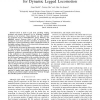396 search results - page 75 / 80 » How scientific models can explain |
IROS
2006
IEEE
14 years 1 months ago
2006
IEEE
— There is much to gain from providing walking machines with passive dynamics, e.g. by including compliant elements in the structure. These elements can offer interesting propert...
NAACL
2010
13 years 5 months ago
2010
In this paper we present an opinion summarization technique in spoken dialogue systems. Opinion mining has been well studied for years, but very few have considered its applicatio...
MOBIQUITOUS
2008
IEEE
14 years 2 months ago
2008
IEEE
In 1969, Thomas Schelling proposed one of the most cited models in economics to explain how similar people (e.g. people with the same race, education, community) group together in...
ATAL
2011
Springer
12 years 7 months ago
2011
Springer
The field of multiagent decision making is extending its tools from classical game theory by embracing reinforcement learning, statistical analysis, and opponent modeling. For ex...
WWW
2002
ACM
14 years 8 months ago
2002
ACM
The Web graph is a giant social network whose properties have been measured and modeled extensively in recent years. Most such studies concentrate on the graph structure alone, an...


